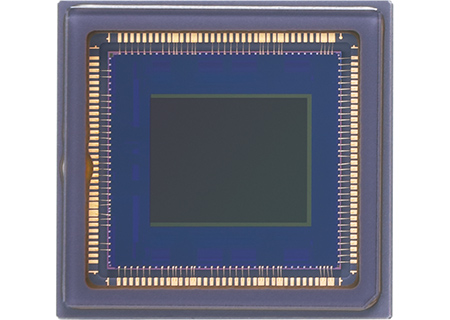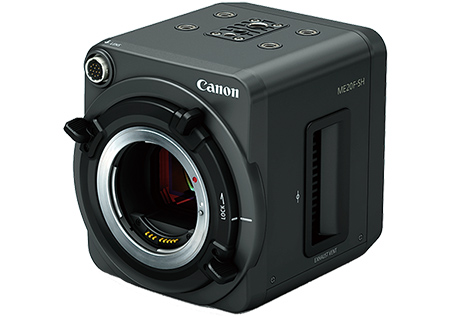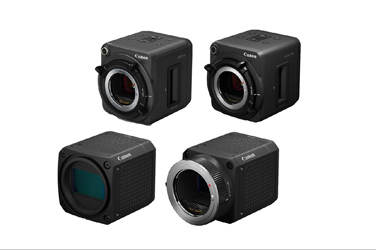

Cutting-Edge CMOS Sensors
Canon has developed CMOS sensor technology from the ground up for its digital SLR cameras.
Bringing greater convenience and safety to the world by making visible that which could not be seen before.
July 11, 2019Featured Technology
CMOS Sensor Featuring a Global Shutter
CMOS Sensor Captures Fast-Moving Subjects without Distortion
An issue facing conventional CMOS sensors, which sequentially expose pixels one row at a time, is that fast-moving subjects can become distorted in the image produced.
To that end, Canon has implemented a newly developed scanning method that exposes all of the sensor’s pixels at the same time. This makes possible the capture of distortion-free images even when shooting fast-moving subjects, which is required for such industrial applications as product inspection. Although there were initial concerns about the power consumption necessary to achieve a high frame rate of 120 frames per second with a full-frame readout, a low power consumption was achieved using proprietary Canon circuit technology. What’s more, as less heat is generated by the sensor, the camera body doesn’t need to be made larger to accommodate a heat sink, allowing for more compact camera designs.The sensor has strong potential for use in cameras that inspect parts on belt conveyors at factories and for aerial cameras mounted on drones.

3U5MGXSC


Photo taken with rolling shutter


Photo taken with global shutter
Ultra-high-Sensitivity 35mm Full-frame CMOS sensor
A CMOS Sensor Capable of Clear Color-Image Capture by the Light of a Crescent Moon
From surveillance to observing natural phenomena, there is a growing need to capture video in the dark. By increasing size of the sensor’s pixels, allowing them to capture more light, Canon has developed an ultra-high-sensitivity sensor capable of Full HD video capture in color with reduced noise, even in low-light environments where subjects would be difficult to discern with the naked eye.
This CMOS sensor features pixels measuring 19 μm (μm=micron, one millionth of a meter) square, which is more than 7.5-times the surface area of the pixels on the CMOS sensors incorporated into Canon’s top-of-the-line EOS-1D X Mark II and other DSLR cameras.
The sensor makes possible video capture with as little as 0.001 lux of illumination, roughly the equivalent of starlight, and was even used to successfully capture footage of a rare phenomenon known as a moonbow, a rainbow produced by moonlight.
The sensor is expected to be used for such applications as astronomical observation, monitoring natural disasters, crime prevention and the observation of microorganisms in low light, as well as for wildlife photography and video production.

ME20F-SH
Comparison of images captured under identical conditions


Captured using a typical professional-use video camcorder


Captured using the Canon ME20F-SH ultra-high-sensitivity multi-purpose camera
Ultra-High-Resolution 250 Megapixel CMOS Sensor
CMOS Sensor Can Identify Lettering on Aircraft Fuselage 18 km Away
Canon was quick to launch R&D efforts on CMOS sensors as far back as the 1990s. In 2010, the company produced a CMOS sensor with 120 megapixels, achieving a level of resolution equivalent to that of the human eye, a feat that garnered considerable attention. In 2015, Canon successfully developed an APS-H-size CMOS sensor with approximately 250 megapixels (19580 x12600 pixels), the world’s highest pixel count for its size*. This ultra-high-pixel-count CMOS sensor achieves a level of resolution that is approximately 125 times that of Full HD (1920x 1080 pixels) video and approximately 30 times that of 4K (3840 x 2160 pixels) video.
Despite the compact pixel dimensions, sensitivity was maintained by creating a structure that maximizes the amount of light captured. Though increases in pixel count results in increased signal volume, which can cause signal delays and timing discrepancies, an ultra-high-speed signal readout of 1.25 billion pixels per second was achieved through circuit miniaturization and enhanced signal-processing technology. Accordingly, the sensor is capable of capturing ultra-highpixel-count video at a speed of five frames per second.
- *As of December 31, 2017. Based on a Canon survey

CMOS sensor with approximately 250 megapixels

Image captured with a prototype camera equipped with an EF 800 mm telephoto lens using digital zoom. The image was digitally enlarged, and additional image processing was applied. The resulting image enables the identification of lettering on the fuselage of an airplane 18 km away, beyond impossible for the human eye.




